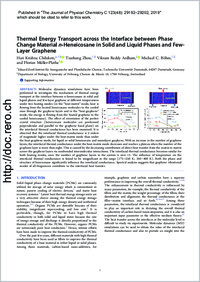Thermal energy transport across the interface between phase change material n-heneicosane in solid and liquid phases and few-layer graphene
- Chilukoti, Hari Krishna Eduard-Zintl-Institut für Anorganische und Physikalische Chemie, Technische Universität Darmstadt, 64287 Darmstadt, Germany
- Zhou, Tianhang Eduard-Zintl-Institut für Anorganische und Physikalische Chemie, Technische Universität Darmstadt, 64287 Darmstadt, Germany
- Ardham, Vikram Reddy Department of Biology, University of Fribourg, Chemin du Musée 10, 1700 Fribourg, Switzerland
- Böhm, Michael C. Eduard-Zintl-Institut für Anorganische und Physikalische Chemie, Technische Universität Darmstadt, 64287 Darmstadt, Germany
- Müller-Plathe, Florian Eduard-Zintl-Institut für Anorganische und Physikalische Chemie, Technische Universität Darmstadt, 64287 Darmstadt, Germany
-
05.12.2019
Published in:
- The Journal of Physical Chemistry C. - 2019, vol. 123, no. 48, p. 29192–29202
English
Molecular dynamics simulations have been performed to investigate the mechanism of thermal energy transport at the interface between n-heneicosane in solid and liquid phases and few-layer graphene at different temperatures under two heating modes (in the “heat-matrix” mode, heat is flowing from the heated heneicosane molecules to the cooled ones through the graphene layers and in the “heat-graphene” mode, the energy is flowing from the heated graphene to the cooled heneicosane). The effect of orientation of the perfect crystal structure (heneicosane molecules are positioned perpendicular and parallel to the graphene basal plane) on the interfacial thermal conductance has been examined. It is observed that the interfacial thermal conductance is 2 orders of magnitude higher under the heat-matrix mode than under the heat-graphene mode, for liquid or solid heneicosane and monolayer graphene. With an increase in the number of graphene layers, the interfacial thermal conductance under the heat-matrix mode decreases and reaches a plateau when the number of the graphene layer is more than eight. This is caused by the decreasing contribution of direct heat transfer from the matrix to matrix across the graphene layers via nonbonded intermolecular interactions. The interfacial thermal conductance becomes similar for both heating modes, once the number of graphene layers in the system is over 15. The influence of temperature on the interfacial thermal conductance is found to be insignificant in the range (175–250 K; 350–400 K). Both the phase and structure of heneicosane significantly influence the interfacial conductance. Spectral analysis suggests that graphene vibrational modes of all frequencies contribute to the interfacial heat transfer.
- Faculty
- Faculté des sciences et de médecine
- Department
- Département de Biologie
- Language
-
- English
- Classification
- Chemistry
- License
- License undefined
- Identifiers
-
- RERO DOC 327939
- DOI 10.1021/acs.jpcc.9b07054
- Persistent URL
- https://folia.unifr.ch/unifr/documents/308294
Other files
Statistics
Document views: 76
File downloads:
- ard_tet.pdf: 182
- ard_tet_sm.pdf: 174

